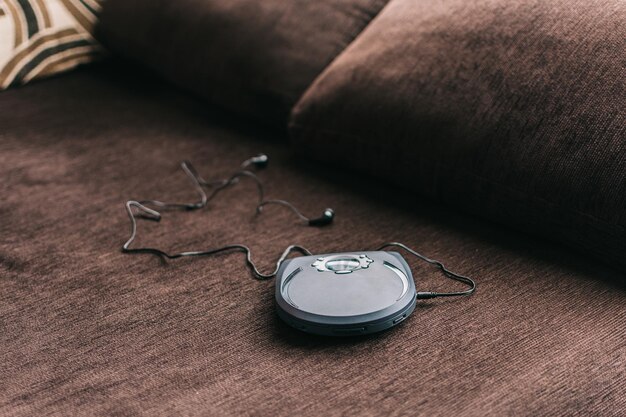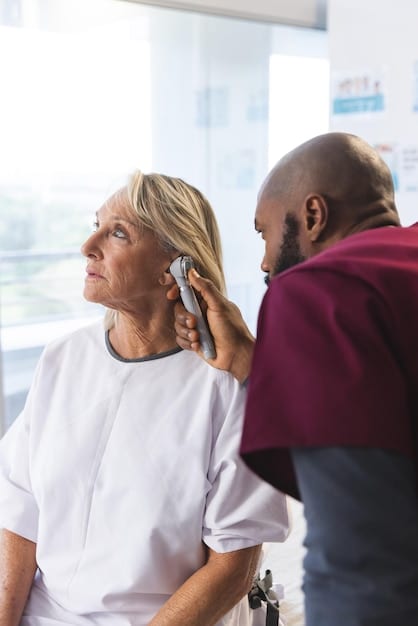Senior Hearing Loss: Latest Hearing Aid Technology & Coverage Options

Senior hearing loss, a common yet often isolating condition, has seen remarkable advancements in hearing aid technology and an evolution in coverage options, offering enhanced clarity and improved quality of life for millions of Americans.
Navigating the complexities of age-related hearing loss can be a daunting experience, not only for individuals but also for their families. However, significant strides in both understanding senior hearing loss: understanding the latest hearing aid technology and coverage options have transformed the landscape of auditory care. This evolving field now offers a myriad of sophisticated solutions designed to reconnect older adults with the vibrant soundscapes of their lives.
The Landscape of Senior Hearing Loss: More Than Just Volume
Hearing loss, clinically known as presbycusis when age-related, is a gradual decline in the ability to hear, particularly high-frequency sounds. It impacts millions of older Americans, making everyday conversations, entertainment, and even safety awareness challenging. Unlike simply turning up the volume, presbycusis often involves a distortion of sound perception, where words become muffled rather than just quiet.
Understanding this distinction is crucial for effective intervention. It’s not just about amplification; it’s about clarity, signal processing, and adapting to individual hearing profiles. This condition can lead to social isolation, cognitive decline, and an increased risk of falls, underscoring the importance of early detection and intervention.
Recognizing the Subtle Signs of Hearing Loss
Often, individuals are the last to acknowledge their hearing difficulties. Family members or close friends might be the first to notice the subtle signs.
- Constantly asking others to repeat themselves.
- Difficulty understanding conversations in noisy environments.
- Turning up the TV or radio volume to an uncomfortable level for others.
- Missing words or sounds, leading to misunderstandings.
These indicators, while seemingly minor, can cumulatively impact quality of life. Prompt recognition and professional evaluation are critical steps toward addressing the issue effectively. The earlier hearing loss is identified, the more successful interventions tend to be, mitigating long-term impacts.

The progression of presbycusis is typically slow and bilateral (affecting both ears). This gradual nature often means individuals adapt unconsciously, making the problem less obvious until it significantly impairs daily functioning. Regular hearing screenings, especially for those over 60, are therefore highly recommended as a preventive health measure.
Beyond the auditory challenges, untreated hearing loss has been linked to other health concerns, including an elevated risk of dementia and depression. This holistic impact highlights why addressing hearing loss is not merely about improving sound perception, but about enhancing overall health and well-being for seniors.
Groundbreaking Advancements in Hearing Aid Technology
The field of hearing aid technology has witnessed a revolution, moving far beyond mere amplification devices. Today’s hearing aids are sophisticated micro-computers capable of processing sound with incredible precision, offering features that were once unimaginable.
Modern hearing aids come in a variety of styles, from nearly invisible in-the-canal (ITC) models to more powerful behind-the-ear (BTE) devices, each designed to meet specific needs and preferences. However, their true innovation lies in the underlying technological capabilities.
Key Technological Innovations Driving Progress
Several advancements stand out, transforming the user experience and effectiveness of hearing aids:
- Digital Sound Processing: These aids convert sound waves into digital signals, allowing for precise manipulation of sound. This means less static, clearer speech, and better suppression of background noise.
- Rechargeable Batteries: Eliminating the need to constantly change tiny batteries, rechargeable options offer convenience and sustainability, with a full day’s power on a single charge.
- Connectivity (Bluetooth): Many new models can directly stream audio from smartphones, TVs, and other devices, turning hearing aids into wireless earbuds for calls, music, and podcasts.
These features not only improve hearing but also integrate seamlessly into modern lifestyles, offering a level of convenience and functionality previously reserved for consumer electronics.
Beyond these, artificial intelligence (AI) and machine learning are beginning to play a significant role. AI-powered hearing aids can learn user preferences and environmental cues, automatically adjusting settings for optimal hearing in various situations. This adaptive capability reduces the need for manual adjustments and provides a more natural listening experience.
Another crucial innovation is directional microphones, which can focus on sounds coming from specific directions while simultaneously reducing noise from other areas. This is particularly beneficial in challenging acoustic environments like restaurants or social gatherings, where understanding speech amidst chatter is often a major hurdle for individuals with hearing loss.
Telehealth integration is also on the rise, allowing audiologists to fine-tune hearing aids remotely through smartphone apps. This provides greater flexibility and accessibility for adjustments, especially for seniors who may have mobility challenges or live in remote areas, ensuring ongoing optimal performance of their devices.
Navigating Hearing Aid Coverage Options in the US
One of the most significant barriers to accessing hearing aid technology for seniors in the US has historically been the cost. Hearing aids can be expensive, and coverage options have traditionally been limited. However, the landscape is gradually shifting, offering more avenues for financial assistance.
Understanding these options is crucial for seniors and their families as they explore solutions for age-related hearing loss. Knowing where to look for support can significantly alleviate the financial burden and ensure access to necessary care.
Medicare and Medicaid Coverage
Traditional Medicare (Parts A and B) generally does not cover hearing aids or routine hearing exams. This is a common point of confusion and frustration for many seniors.
- Medicare Part A (Hospital Insurance): Covers inpatient hospital stays and skilled nursing facility care, but not routine hearing care.
- Medicare Part B (Medical Insurance): Covers medically necessary services, but explicitly excludes hearing aids and exams for fitting them.
However, there are exceptions and alternative routes. Medicare Advantage Plans (Part C), offered by private companies approved by Medicare, often include benefits that original Medicare doesn’t, such as dental, vision, and crucially, hearing care.
These plans vary widely, so it’s essential to compare different Medicare Advantage plans to find one that offers robust hearing aid coverage. Some plans may provide a specific allowance for aids, while others might cover a portion of the cost or offer a network of providers with discounted prices.
Medicaid, a state and federal program that provides health coverage to low-income individuals and families, often covers hearing aids and related services, particularly for children. For adults, coverage varies significantly by state, with some states offering comprehensive benefits while others provide limited or no coverage.
It’s important for eligible seniors to check their specific state’s Medicaid guidelines regarding hearing aid benefits and any income or asset limitations that may apply.

Beyond government programs, some private insurance plans may offer limited coverage for hearing aids or discounted programs. Reviewing individual insurance policies carefully and contacting the insurance provider directly is a necessary step to understand potential benefits.
Additionally, various foundations and charitable organizations provide financial assistance or refurbished hearing aids to those in need. Organizations like the Hearing Loss Association of America (HLAA) often have resources pointing to such programs and advocacy efforts aimed at increasing access to affordable hearing care.
The Over-the-Counter (OTC) hearing aid rule, largely impacting milder forms of hearing loss, is a relatively new development that aims to reduce costs and increase accessibility. While not traditional coverage, it offers a more affordable entry point for some individuals, bypassing the need for a professional fitting in certain cases. However, it’s prudent to consult with an audiologist to ensure proper diagnosis and device selection, even with OTC options.
The Evolution of Hearing Healthcare: Beyond the Device
Modern hearing healthcare extends far beyond simply fitting a device. It encompasses a holistic approach to auditory rehabilitation, acknowledging that adapting to hearing aids and maximizing their benefits requires ongoing support and training.
Audiologists play a pivotal role in this process, guiding individuals through the entire journey, from initial diagnosis to long-term maintenance and fine-tuning. This comprehensive care model is essential for ensuring successful outcomes and optimizing the quality of life for seniors with hearing loss.
Key Components of Modern Hearing Healthcare
Effective hearing healthcare involves a multi-faceted approach:
- Thorough Diagnostic Evaluations: Accurate assessment of hearing loss type, degree, and specific challenges is the foundation for personalized treatment.
- Personalized Device Selection and Fitting: Choosing the right hearing aid involves considering individual lifestyle, hearing needs, cosmetic preferences, and budget, followed by precise calibration to the user’s audiogram.
- Aural Rehabilitation: This includes counseling, communication strategies training, and auditory training exercises to help the brain re-learn how to process sounds with the aid of amplification.
This integrated approach recognizes that the brain plays a significant role in interpreting sound, and that simply amplifying sound is often not enough. Aural rehabilitation helps individuals maximize the utility of their hearing aids, improving their ability to understand speech and navigate different listening environments.
Follow-up appointments are critical for fine-tuning the devices and addressing any concerns that arise as the individual adapts to their new hearing. These sessions allow audiologists to make adjustments based on real-world feedback, ensuring continued comfort and efficacy of the hearing aids.
The role of family and friends is also increasingly recognized in the modern hearing healthcare model. Their understanding and support can significantly impact a senior’s success with hearing aids, encouraging consistent use and participation in communication strategies.
Furthermore, education about hearing loss itself – its causes, effects, and management – empowers individuals and their loved ones to be active participants in their care. This shift from a purely medical model to a more patient-centered, educational approach is a hallmark of modern hearing healthcare.
Future Outlook: Innovations and Policy Changes Ahead
The trajectory for senior hearing loss care is characterized by ongoing innovation, both technologically and in terms of policy. The convergence of advanced engineering, artificial intelligence, and a growing public awareness is painting a promising picture for the future.
Anticipated advancements range from even more discreet and powerful devices to more accessible and affordable care models. These developments aim to break down existing barriers, making effective hearing solutions available to a wider segment of the elderly population.
Emerging Trends and Potential Policy Shifts
Several areas are poised for significant growth and impact:
- AI and Machine Learning Refinements: Expect even smarter hearing aids that adapt not just to environments but also to individual cognitive load and listening fatigue, offering personalized soundscapes in real-time.
- Miniaturization and Improved Aesthetics: Devices will likely become even smaller and less noticeable, appealing to those concerned about the stigma associated with wearing hearing aids.
- Increased Integration with Health Monitoring: Future hearing aids may incorporate health tracking features, like fall detection or heart rate monitoring, turning them into comprehensive wellness devices.
- Tele audiology Expansion: Remote diagnostics, fittings, and adjustments will become more commonplace, improving accessibility, particularly for individuals in rural areas or with limited mobility.
On the policy front, there’s growing advocacy for Medicare to include comprehensive hearing aid coverage. While the Over-the-Counter (OTC) hearing aid rule was a step, advocates continue to push for broader governmental support, recognizing hearing health as an integral part of overall health.
State-level initiatives are also exploring expanded Medicaid benefits and other subsidy programs to address the financial barrier. The increasing recognition of hearing loss’s link to cognitive decline and other health issues might further accelerate policy changes, as preventative care becomes a higher priority.
The development of gene therapies and other biological interventions for certain types of hearing loss is also a long-term goal for research. While still in early stages, these advancements could one day offer restorative solutions for irreversible hearing damage, moving beyond amplification to actual biological repair.
The future of hearing healthcare seems bright, promising not just enhancements in technology but also a more equitable and integrated approach to care that prioritizes the well-being and active participation of seniors in society.
Making Informed Decisions: A Guide for Seniors and Caregivers
For seniors experiencing hearing loss and their caregivers, the array of choices in technology and coverage can be overwhelming. Making an informed decision requires careful consideration, research, and collaboration with healthcare professionals. It’s not a one-size-fits-all solution, and what works best for one individual may not be ideal for another.
Empowering oneself with knowledge about various options, understanding personal needs, and seeking expert advice are crucial steps toward a successful outcome. This section aims to provide a framework for navigating these important choices.
Steps to Consider When Seeking Hearing Aid Solutions
A systematic approach can simplify the decision-making process:
- Consult an Audiologist: A comprehensive hearing test by a qualified audiologist is the first and most critical step. They can accurately diagnose the type and degree of hearing loss and recommend appropriate solutions.
- Explore Technology Options: Research different hearing aid styles, features (e.g., rechargeable, Bluetooth, AI), and brands. Discuss with your audiologist which technologies best suit your hearing profile and lifestyle.
- Investigate Coverage and Financial Aid: Contact your insurance provider, compare Medicare Advantage plans, check state Medicaid programs, and look into charitable organizations for financial assistance or discounts.
Remember that the best hearing solution is one that not only addresses the auditory deficit but also fits comfortably into the individual’s daily life and budget. Don’t hesitate to ask questions and seek second opinions if needed.
Consider a trial period for hearing aids, if available. Many providers offer a period during which devices can be tested and returned or exchanged, allowing individuals to experience the aids in real-world situations before committing to a purchase.
Beyond the initial purchase, understand the ongoing support and maintenance requirements. This includes follow-up appointments for adjustments, cleaning, and repairs. A good relationship with your audiologist is key to long-term success.
Finally, engage in aural rehabilitation and learn communication strategies. This proactive approach can significantly enhance the benefits derived from hearing aids, improving overall communication effectiveness and reducing feelings of isolation.
| Key Point | Brief Description |
|---|---|
| 👂 Hearing Loss Nature | Age-related loss often involves distortion, not just volume, impacting clarity. |
| 💡 Tech Innovations | Modern aids feature digital processing, Bluetooth, AI, and rechargeability. |
| 💰 Coverage Options | Original Medicare lacks coverage; Medicare Advantage and Medicaid vary. |
| ✅ Informed Decisions | Consult audiologists, explore options, and understand financial aid resources. |
Frequently Asked Questions About Senior Hearing Loss and Hearing Aids
▼
No, Original Medicare (Parts A and B) generally does not cover hearing aids or routine hearing exams. However, Medicare Advantage Plans (Part C), offered by private insurers, often include benefits for hearing aids and related services, varying widely by plan and provider.
▼
Modern hearing aids feature significant advancements such as digital sound processing for clearer audio, rechargeable batteries for convenience, Bluetooth connectivity for streaming from devices, and increasingly, artificial intelligence (AI) for adaptive sound environments and personalized experiences.
▼
OTC hearing aids offer a more accessible and potentially affordable option for adults with perceived mild to moderate hearing loss, bypassing a prescription or professional fitting. While convenient, consultation with an audiologist is still advisable to ensure proper diagnosis and device suitability for individual needs.
▼
Audiologists are crucial for comprehensive hearing care, providing thorough diagnostic evaluations, precise hearing aid selection and fitting, and essential aural rehabilitation. They offer ongoing support, fine-tuning devices, and guiding seniors in communication strategies to maximize the benefits of their hearing aids.
▼
Yes, numerous studies suggest a link between untreated hearing loss and an increased risk of cognitive decline, including dementia. The brain may expend more energy trying to process sounds, leading to reduced cognitive reserve. Addressing hearing loss can potentially mitigate this risk, supporting overall brain health.
Conclusion
Addressing senior hearing loss is a critical component of healthy aging, directly impacting an individual’s quality of life, social engagement, and overall cognitive and emotional well-being. The rapid evolution of hearing aid technology has democratized access to clearer sound, offering sophisticated solutions that are more discreet, powerful, and integrated into modern life than ever before. While challenges remain, particularly regarding coverage, understanding the available options, from advanced devices to evolving financial assistance programs, empowers seniors and their caregivers to make informed decisions. By embracing these advancements and seeking expert guidance, older adults can reconnect with the world of sound, fostering greater independence and richer connections.





